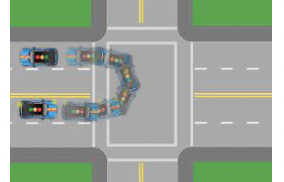Navigating the intricate web of traffic laws is crucial for every driver, ensuring a safe and legal journey on Nevada’s roads. One often misunderstood maneuver is the U-turn. In this guide, we’ll explore the ins and outs of making a U-turn in the Silver State, shedding light on when it’s legal and safe.
Before we dive into the legality, let’s refresh our understanding of what a U-turn entails. A U-turn is a driving maneuver where a driver turns their vehicle 180 degrees to head in the opposite direction. This maneuver is not a one-size-fits-all solution and must be executed with caution and adherence to traffic laws.
When U-turns are Generally Prohibited
In Nevada, there are specific scenarios where making a U-turn is generally prohibited. These include:
Intersections with Traffic Lights:
- Making a U-turn at intersections controlled by traffic lights is typically not allowed. This regulation aims to prevent disruptions to the flow of traffic and potential conflicts with other drivers.
Intersections with “No U-Turn” Signs:
- Keep an eye out for signs explicitly prohibiting U-turns. These signs are strategically placed to indicate areas where making a U-turn could be unsafe or cause traffic hazards.
In Business Districts:
- Within business districts, making U-turns is often restricted. The presence of pedestrians, increased traffic, and the potential for congestion make U-turns less feasible in these areas.
Exceptions to the Rule:
- Despite these general prohibitions, there are exceptions to the rule. Certain situations allow for legal U-turns, even at traffic lights and in business districts.
When Legal U-Turns are Permitted
Understanding when a U-turn is legal is just as vital as knowing when it’s prohibited. Legal U-turn scenarios in Nevada include:
No “No U-Turn” Signs:
- If there are no signs explicitly forbidding U-turns, you are generally permitted to make a U-turn. However, exercise caution and ensure that it can be done safely.
Safe and Clear Visibility:
- Before attempting a U-turn, ensure that you have a clear view of oncoming traffic. If there’s a reasonable distance between you and other vehicles, and you can safely execute the turn without impeding traffic, it’s likely legal.
Intersections without Traffic Lights:
- At intersections without traffic lights, you may make a U-turn unless signs or road markings indicate otherwise. Always be attentive to any posted regulations.
Emergency Situations:
- In emergencies where it is necessary to change direction quickly and safely, making a U-turn may be justified. However, this should be done with extreme caution, taking into account the surrounding traffic conditions.
Legal Consequences of Illegal U-Turns
Understanding the legal consequences of making an illegal U-turn is crucial. According to THE702FIRM Injury Attorneys, violators may face fines, points on their driving record, and increased insurance premiums.
Additionally, engaging in an accident while making an illegal U-turn could lead to liability issues.
Conclusion
In conclusion, mastering the art of legal U-turns in Nevada is about being informed and vigilant. Pay attention to signage, exercise caution, and always prioritize safety. If in doubt, it’s better to find an alternative route than risk the legal consequences.
Remember, safe driving not only protects you but also contributes to the overall well-being of everyone on the road.




